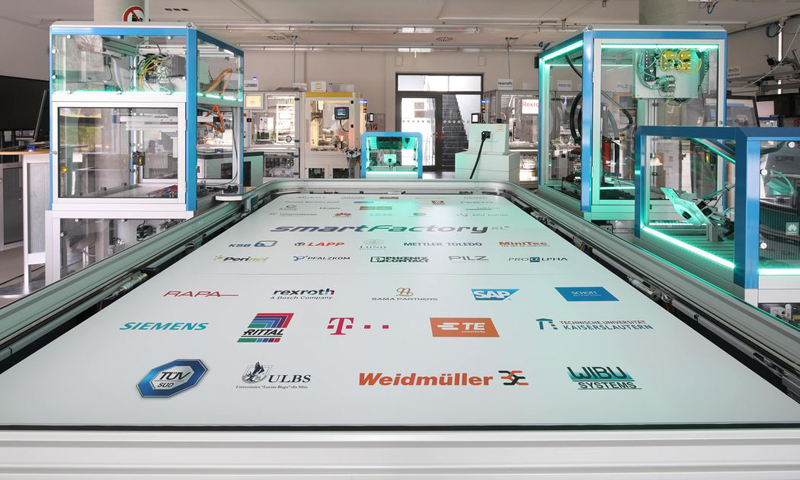Production Level 4 demonstrator

The Hannover Messe Digital Edition offered the fans of factory of the future concepts a unique chance to see the Production Level 4 demonstrator. With the new demo factory, SmartFactory continues to build on the experience it gained with the Industry 4.0 demonstrator that was one of the eye-catchers at the Hannover Messe for many years.
On Productivity.be we have always paid a lot of attention to the Industry 4.0 demonstrator of SmartFactory because it gave a good picture of the state of affairs in the technologies and insights for the factory of the future. Year after year, the demonstrator was expanded and new concepts such as mobile robots, artificial intelligence and edge computing appeared.
For the first time, there is now a completely new demonstrator and at first glance it seems an important step back due to its modest set-up. There are only four modular units around a central conveyor, each of which takes care of a production step. In the first step of the demo factory, USB sticks are produced by clicking a Lego block on a USB stick. In the second step, that block could be marked with a logo. In the third step, data can be put on the stick and a quality check is done in the final station.
One central machine
Personalized production on machines that are designed in a modular way - that's the idea behind the Production Level 4 demonstrator, but that was already the case in the good old Industry 4.0 demo. Still, there are some very fundamental changes - so fundamental that it's fair to say that SmartFactory has basically just started over.
In explaining the new name, Martin Ruskowski, CEO of SmartFactory, points out the important role that humans play and will continue to play in industrial production: “We often see a reflexive implementation of automation, but that is a mistake. The diverse and creative possibilities of people can never be replaced by machines or artificial intelligence. ”
Where Industry 4.0 went, or at least wanted to go, very far in autonomous systems, in Production Level 4 this automation is once again at the service of people, who are the manager of a production line and take the important decisions.
And so we come to an almost invisible but fundamental difference between the old and the new demonstrator. In Industry 4.0 it was the intention that a production line could be put together ad-hoc by linking autonomous modules to each other.
In the new concept there is again a heart of the machine, which is symbolized by the central conveyor to which the modules are connected. The heart of the machine - that is also a central control with its own interfaces for the operators and data interfaces to the outside world. People, who are so important in Production Level 4, manage that machine, among other things by connecting modules to it and changing them if necessary. These modules are no longer autonomous but serve the central machine.
Machine safety
In the demonstrations given at the Hannover Messe Digital Edition with the new production line, a strong emphasis is placed on machine safety and how it is implemented in the new concept. It is not said in so many words, but perhaps that is also the main motivation behind the new concept of the Production Level 4 demonstrator.
After all, in the old system with autonomous modules that could be linked to each other according to needs, machine safety was a pain point. After all, before the Machinery Directive, those modules were only parts of a machine. According to the directive, it is up to the user of a machine, once it has been assembled, to make a risk analysis and implement the necessary safety elements based on this. All those security measures together must form one comprehensive whole that adequately covers all risks.
In recent years, in collaboration with TÜV, a safety concept was sought that could reconcile the requirements of the machinery directive with the great flexibility of a fully modular factory, but a conclusive solution was never found.
In the new demonstrator with its centralized approach, machine safety can be implemented in an elegant and effective way. After all, a risk analysis can be made for the central machine that takes into account all possible modules that may or may not be switched on in the line. The safety control can then monitor in real time which configuration is active and adjust the security of the whole accordingly. The modular factory is still very flexible, but that is limited to a finite number of possible scenarios that have been predefined and analyzed.
And so we come back to the central role of people who manage what is possible with the production line and who can also estimate the consequences this may have for safety.
© Productivity.be, 12/04/2021, Picture: DFKI
Feel free to share
Calendar
22/04 - 26/04: Hannover Messe, Hannover (D)
14/05 - 16/05: Advanced Manufacturing, Antwerp Expo (B)
15/05 - 16/05: Advanced Engineering, Antwerp Expo (B)
15/05 - 16/05: Food Tech Event, Brabanthallen, 's-Hertogenbosch (Nl)
28/05: Industrie & Maintenance, Namur Expo (B)
05/06 - 06/06: Vision, Robotics & Motion, Brabanthallen, 's-Hertogenbosch
10/06 - 14/06: ACHEMA, Frankfurt am Main (D)
18/09 - 19/09: Kunststoffen, Brabanthallen 's-Hertogenbosch (Nl)
08/10 - 11/10: Motek, Stuttgart (D)
15/09/25 - 19/09/25: Schweissen & Schneiden, Messe Essen (D)
08/10/25 - 15/10/25: K, Düsseldorf (D)
